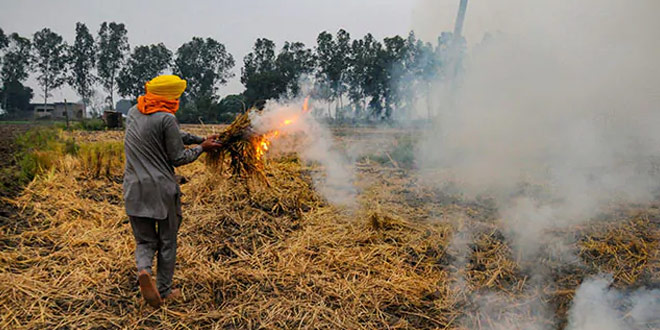Highlights
- Bio-decomposer is one of the solutions for addressing farm fires: Experts
- Every year at the onset of winters, farm fires begins in Punjab, Haryana
- Haryana saw farm fire incidents reducing by 28.6 per cent this year
New Delhi: Punjab recorded the highest number of stubble burning incidents this year, registering an increase of 46.5 per cent as compared to last year, according to the Central Pollution Control Board (CPCB). However, Haryana saw farm fire incidents reducing by 28.6 per cent this year. Every year at the onset of winters, crop residue burning or stubble burning begins in Punjab and Haryana leading to heavy air pollution in Delhi.
Also Read: Stubble Burning Continues In Parts Of Punjab
In its data released on Tuesday (November 24), pollution watchdog CPCB said the total count of active fire events reported in Punjab in 2020 is 76,537 while in 2019 it was 52,225 (between 21 September and 22 November).
“Stubble burning has increased by 46.5 per cent (or 24312 number of incidents) during 2020 in comparison to 2019,” the apex pollution control body said. In 2020, districts such as Sangrur, Bathinda and Firozpur continue to be highest contributor to active farm fire events in comparison to 2019, it said.
In 2020, districts such as Moga, Amritsar, Fazilka, Ludhiana have shown more than 75 per cent increase in their number of fire counts in comparison to 2019.
“In 2020, all the districts of Punjab except SBS Nagar have shown an upward trend in their active fire events contribution,” the CPCB said, adding it showed lack of ground level implementation of the Central supported scheme.
The average contribution of external biomass burning to PM 2.5 has increased from 10 per cent in 2019 to 15.63 per cent in 2020. The maximum contribution of external biomass burning to PM 2.5 at 42 per cent was observed on November 5, 2020. In Haryana, total count of fires reported in 2020 is 4,675 while in 2019 it was 6551 (between September 25 and November 22).
With the support of central government schemes initiated to stop stubble burning, about 28.6 per cent (1876 incidents) of stubble burning reduced in 2020 in comparison to 2019, the CPCB said.
In 2020, districts such as Fatehabad, Kaithal and Karnal continue to be major contributors to farm fires but still have shown reduction by 40 per cent in comparison to 2019, it said. Districts such as Palwal and Kurushetra have shown major reduction by 50-60 per cent this year in comparison to 2019, it said.
The pollution watchdog also said that under the central government scheme ‘Promotion of Agricultural Mechanization for In-Situ Management of Crop Residue in the States of Punjab, Haryana, Uttar Pradesh and NCT of Delhi’, funds worth Rs 1178.47 crores were released from 2018-2020 and it has been approved for continuation during 2020-21 with Rs 600 crores.
Union Environment Minister Prakash Javadekar had earlier said that the central government’s PUSA institute has demonstrated a bio-decomposer technology which converts stubble to manure and is being experimented on a pilot basis in five states including Delhi and its trial is on.
“It will help in dealing with crop residue and is cheap as well. In the future, there will be several ways, both in-situ and ex-situ, to fight against the problem of pollution emerging out of stubble burning,” he had said.
Delhi Environment Minister Gopal Rai had on Tuesday said that a 15-member impact assessment committee has ascertained the effectiveness of “Pusa bio-decomposer” solution in reducing stubble burning in the capital and it was submitted to the Environment Ministry’s Commission for Air Quality Management in National Capital Region and Adjoining Areas on Monday.
Also Read: 297 Stubble Burning Incidents Reported From Punjab From September 21 To 25, 100 More Than Last Year
(Except for the headline, this story has not been edited by NDTV staff and is published from a syndicated feed.)
NDTV – Dettol Banega Swasth India campaign is an extension of the five-year-old Banega Swachh India initiative helmed by Campaign Ambassador Amitabh Bachchan. It aims to spread awareness about critical health issues facing the country. In wake of the current COVID-19 pandemic, the need for WASH (Water, Sanitation and Hygiene) is reaffirmed as handwashing is one of the ways to prevent Coronavirus infection and other diseases. The campaign highlights the importance of nutrition and healthcare for women and children to prevent maternal and child mortality, fight malnutrition, stunting, wasting, anaemia and disease prevention through vaccines. Importance of programmes like Public Distribution System (PDS), Mid-day Meal Scheme, POSHAN Abhiyan and the role of Aganwadis and ASHA workers are also covered. Only a Swachh or clean India where toilets are used and open defecation free (ODF) status achieved as part of the Swachh Bharat Abhiyan launched by Prime Minister Narendra Modi in 2014, can eradicate diseases like diahorrea and become a Swasth or healthy India. The campaign will continue to cover issues like air pollution, waste management, plastic ban, manual scavenging and sanitation workers and menstrual hygiene.
[corona_data_new]





























